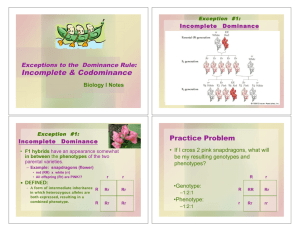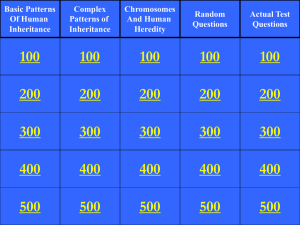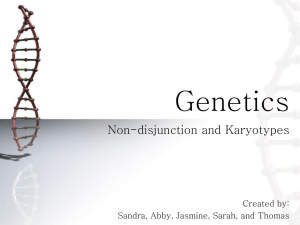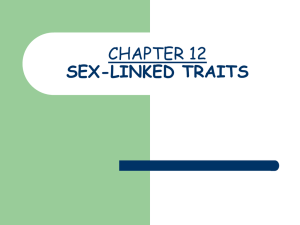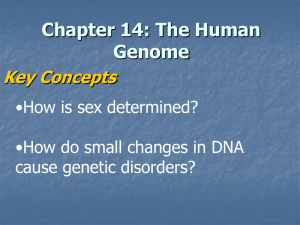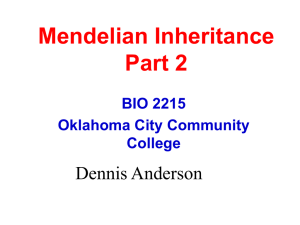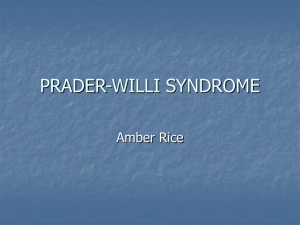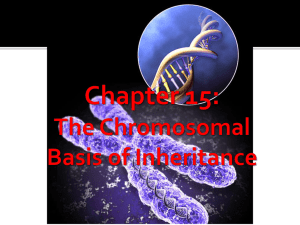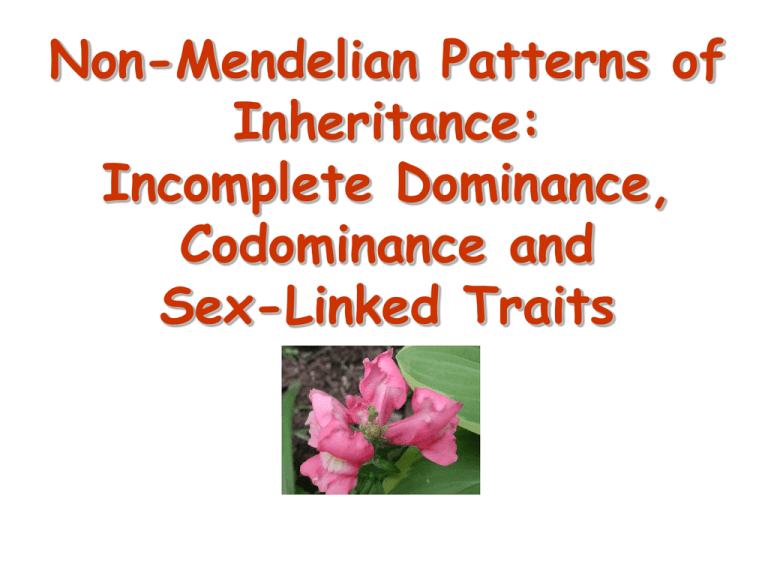
Non-Mendelian Patterns of
Inheritance:
Incomplete Dominance,
Codominance and
Sex-Linked Traits
1
Incomplete Dominance
F1 hybrids have an appearance somewhat
in between the phenotypes of the two
parental varieties.
Example: snapdragons (flower)
red (RR) x white (rr)
r
r
RR = red flower
rr = white flower
R
R
2
Incomplete Dominance
r
r
R Rr
Rr
R Rr
Rr
produces the
F1 generation
All Rr = pink
(heterozygous pink)
3
Incomplete Dominance
4
Incomplete Dominance
Blending of alleles to produce a different
phenotype from either parent
5
Codominance
Two alleles are expressed (multiple
alleles) in heterozygous individuals.
Example: blood type
Phenotype
1. type A
2. type B
3. type AB
4. type O
=
=
=
=
Genotype
IAIA or IAi
IBIB or IBi
IAIB
ii
6
Codominance Problem
Example: homozygous male Type B (IBIB)
x
heterozygous female Type A (IAi)
IA
i
IB
IAIB
IBi
IB
IAIB
IBi
1/2 = IAIB
1/2 = IBi
7
Another Codominance Problem
• Example: male Type O (ii)
x
female type AB (IAIB)
IA
IB
i
IAi
IBi
i
IAi
IBi
1/2 = IAi
1/2 = IBi
8
Codominance
Question:
If a boy has a blood type O and
his sister has blood type
AB,
what are the genotypes
and
phenotypes of their
parents?
boy - type O (ii)
AB (IAIB)
X
girl - type
9
Codominance
Answer:
IA
IB
i
i
IAIB
ii
Parents:
genotypes = IAi and IBi
phenotypes = A and B
10
Pattern of Inheritance
Complete Dominance - 1 allele overshadows
the other allele in a heterozygous individual
Incomplete Dominance – blending of alleles
to produce a different phenotype from
either parent
(Ex. Red rose X White rose = Pink rose)
Codominance – both alleles of a gene are
expressed
(Ex. Red rose X White rose = red/white
rose)
Incomplete or Codominance?
12
Incomplete or Codominance?
13
More Patterns of Inheritance
•
•
•
•
•
Autosomal inheritance – genes are located on
the autosomes, same for both male and female
Sex-linked inheritance – genes located on the
sex chromosomes, different for male and female
Sex-influenced traits – sex hormones create
different phenotypes in males and females (Ex.
Baldness)
Multiple alleles – has more than 2 alleles for the
same gene (Ex. blood types)
Polygenic inheritance – coded for by many genes
(skin color, hair color, height)
14
Blood Type
•
••
••
••
Multiple Alleles – 3 or more alleles code for a
trait
Codominant Inheritance
Blood types – A, B, AB, O are coded by 3 alleles
(A, B, O)
Universal Donor – O
Universal Recipient – AB
RH+ - antigen present
RH- - no antigen present
15
16
17
Sex-linked Traits
Traits (genes) located on the sex
chromosomes
Sex chromosomes are X and Y
XX genotype for females
XY genotype for males
Many sex-linked traits carried on
X chromosome
18
Sex-linked Traits
Example: Eye color in fruit flies
Sex Chromosomes
fruit fly
eye color
XX chromosome - female
Xy chromosome - male
19
Genes on the Male Sex Chromosomes
XH
XH
Y
DOMINANT
RECESSIVE
Xh
XHXH
XHXh
XHY
XhY
Sex-linked Inheritance
Color Blindness – recessive, on X chromosome
Normal Vision is dominant
Genotypes:
XCXC – normal female, non carrier
XCXc’ – normal female, carrier (may pass
recessive allele on to sons and/or
daughters)
Xc’Xc’ – colorblind female (will pass recessive
allele to all children
XCY – normal male
Xc’Y – colorblind male (will pass recessive
allele to daughters only)
~Hemophilia – bleeder’s disease, recessive,
linked to the X chromosome
Protein Factor VIII or IX is missing but is
necessary to clot blood
Genotypes:
XHXH – normal female, non carrier
XHXh – normal female, carrier
XhXh – hemophiliac female
XHY – normal male
XhY – hemophiliac male
Female Carriers
24
Sex-linked Trait Problem
Example: Eye color in fruit flies
(red-eyed male) x (white-eyed female)
XRY
x
XrXr
Remember: the Y chromosome in males
does not carry traits.
Xr
Xr
RR = red eyed
Rr = red eyed
R
X
rr = white eyed
XY = male
Y
XX = female
25
Sex-linked Trait Solution:
Xr
XR
XR
Xr
Y
Xr Y
Xr
XR
Xr
Xr Y
50% red eyed
female
50% white eyed
male
26
Pedigrees
Making a Pedigree
A family tree traces a family name and various
family members through successive generations.
Through a family tree, you can identify the
relationships among your cousins, aunts, uncles,
grandparents, and great-grandparents.
Pedigrees Illustrate Inheritance
A pedigree is a graphic representation of
genetic inheritance.
It is a diagram made up of a set of
symbols that identify males and females,
individuals affected by the trait being
studied, and family relationships.
Pedigrees Illustrate Inheritance
Male
Parents
Female
Siblings
Affected
male
Affected
female
Mating
Known heterozygotes for
recessive allele
Death
Human Heredity
Pedigrees Illustrate Inheritance
I
Female
Male
1
2
II
2
1
3
4
5
In a pedigree, a
circle represents a
female; a square
represents a male.
III
?
1
2
4
3
IV
1
2
3
4
5
Highlighted circles
and squares
represent individuals
showing the trait
being studied.
Circles and squares
that are not
highlighted
designate individuals
that do not show the
trait.
Human Heredity
Pedigrees Illustrate Inheritance
A half-shaded circle or
square represents a
carrier, a
heterozygous
individual.
Human Heredity
Pedigrees Illustrate Inheritance
I
1
2
3
4
II
2
1
5
III
?
1
2
4
3
IV
1
2
3
4
5
A horizontal line connecting a
circle and a square indicates
that the individuals are
parents, and a vertical line
connects parents with their
offspring.
Each horizontal row of circles
and squares in a pedigree
designates a generation, with
the most recent generation
shown at the bottom.
The generations are identified
in sequence by Roman
numerals, and each individual
is given an Arabic number.
Dd
Dd
DD
Dd
Dd
dd
dd
Dd
dd
dd
dd
Dd
DD
DD DD
DD
DD
Dd
Dd
Dd
dd
DD
Dd
Dd
Dd
Dd
Dd
dd
Dd
dd
DD
Dd
Dd
dd
dd
Dd
dd
dd
dd
dd
dd
Hemophilia pedigree beginning with
Queen Victoria
Genetic Rarities & Abnormalities
What can happen when meiosis goes
awry…
I.
Twins
a) Identical – develop from the same fertilized
egg (zygote), genetically identical, always
same sex
b) Fraternal – 2 sperm fertilize 2 different
eggs, genetically different
Conjoined
Twins
Fusion OR
fission in utero
Chromosome Theory
a)
Each gene occupies a specific place on
chromosome
b)
Gene Mapping – locating and mapping the
position of a gene on the chromosome
c)
Gene Linkage – some genes are linked
together and are inherited together
d)
Crossing Over – produces new allele
combinations and increases variety
Types of Mutations – mistakes
a) Germ mutations – occur in gametes.
Inheritable (colorblindness,
hemophilia)
b) Somatic mutations – affect body cell,
not inheritable (cancer)
c) Chromosomal mutations – most
drastic, change in structure or # of
chromosomes (Downs’ syndrome)
Point Mutations
a) Substitution – one base exchanges for
another, affects 1 amino acid
(Ex. GCA-TCA
GCT-TCA
b) Insertion (frame shift) – 1 base is
inserted, affects several amino acids
Ex. (GCA-TCA
GCA-GTC-A
c) Deletion – base is removed, affects
several amino acids
Ex. (GCA-TCA
GCT-CA
Point Mutation
Frameshift Mutation
Nondisjunction (Chromosomal mutation) –
chromosomes do not separate during
meiosis
Sex Chromosomes
i.
Turner’s Syndrome – XO – 45
chromosomes, female, sterile
ii. Kleinfelter’s syndrome – XXY – 47, XXXY
– 48, or XXXXY – 49 chromosomes,
male, sterile
b)
Autosomes
i.
Down’s syndrome (Trisomy 21) extra 21st
chromosome
ii. Trisomy 8 and 13 – result in miscarriages
a)
Karyotypes
Nondisjunction
Patau’s Syndrome
•1 out of 6,000 births
•Trisomy 13
•80-90% do not survive past 1 yr old
Edward’s Syndrome
•Trisomy 18
•Second most common
trisomy after down’s
syndrome
•Only 5% live to age 1
•1 out of 8,000 births
•Severely retarded, many
die from malformed heart
•Polydactyly or syndactyly
•“ Cry of the Cat”
•Osteogenesis
imperfecta
•Lobstein
syndrome
•Brittle bone
syndrome
•1 in 50,000 births
•Severe mental
retardation
•Low mortality rate
Cri du Chat
Down’s Syndrome
•Trisomy 21
•1 in 700 births
•Mental
retardation
•Males are sterile
but females are
not
XYY-Jacob’s Syndrome a.k.a.
“Super Males”
• 1 in 1,000 men
•Normal appearance, very
tall
•Low IQ, prone to
violence
Klinefelter’s Syndrome
•XXY
•1 in 1,000
•Usually sterile because of
low sperm count
•Tall, sparse body hair
•Suffer from gynecomastiamale breast tissue
•Testosterone treatments
Turner’s Syndrome
•XO genotype—Monosomy X
•1 in 2,500 births
•Short, sterile
•75% result in non-disjunction
from the father
Other Diseases
a) Sickle Cell Anemia – codominant,
causes sickle cell shaped red cells in
hemoglobin, common in people with
African descent
b) Tay-Sachs – metabolic disorder,
deteriorates brain, death by age 4,
recessive is lethal
c) Cystic Fibrosis – thick mucus clogs,
lungs, pancreas, liver. Death by age
20 without proper diet/medication
Sickle cell
How to know…
Family history (mostly probabilities)
Genetic testing (ex: spit test)
Karyotyping
Amniocentesis
Amniocentesis – remove amniotic
fluid to check for genetic disorders

